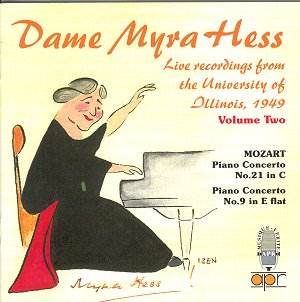The second volume of APR’s invaluable series finds
Myra Hess playing two Mozart concertos closely associated with her.
APR itself released a previously unissued 1942 recording of K467 with
Hess and the Hallé Orchestra conducted by Leslie Heward. Her
1952 Perpignan recording with Casals is well known. So in a sense this
could be seen to be a release ancillary to her known performances. And
yet that would be to underestimate the considerable gains in flexibility,
in freedom, in Hess’s live performances. This series makes those gains
increasingly clear.
In the first volume of this series I reviewed a Chopin
Fantasie that was incendiary – in truth too incendiary – and if there
are no comparable revelations here there are still very real pleasures.
The first is in welcoming the restoration of preserved recordings long
known of – not least from the discography in Marian McKenna’s Hess biography
– but long inaccessible. The University of Illinois has made their original
acetate discs available and Marshall Izen provided tapes of them as
well as writing the liner notes – common to all three volumes – and
also the delicious cover caricature. The quality of the sound is inevitably
compromised and constricted. The balance favours the piano to a degree
rather ruinous to the balance but these are the inevitable limitations
inherent in live recordings of this kind. We can only be grateful that
so much was preserved and that the restoration has made so much listenable.
The University of Illinois Sinfonietta is enthusiastically
variable. Wind counter themes are barely audible in the first movement
of K467 and the prominence of the piano allows us to hear Hess’ crystalline
runs as, equally, the submerged strings encourage us to concentrate
on her articulation of the passagework. She is quicker in the opening
movement than she was seven years earlier with Heward – only to be expected
given the live nature of the music making – with gains in quicksilver
responsiveness. She is especially successful in the sheer limpidity
of her phrasing in the slow movement and her perky and lithe playing
in the finale. Rather delightfully we can hear her asking the audience
if they want to hear the finale again and she then gives it as an encore.
As in the Heward recording she uses Denis Matthews’ cadenzas.
Her K271 was recorded the following evening. There
is here an engaging and rather stimulating frisson between soloist and
orchestra. John Kuypers encourages a rich patina of romantic phrasing
within a broadly romanticised frame. Hess is expressive and wholehearted
but less obviously romantic than the orchestra and the creative tension
engendered is most appealing. There’s no denying the murky sound of
orchestra or the sudden drop-out in the slow movement though.
But here is Hess, at fifty-nine, playing her beloved
Mozart in the most congenial of surroundings and still in infectiously
good form.
Jonathan Woolf


